Yeah, Greens are getting smashed this game. Highlandcharge is in a desperate position with the Volga cut off from his capital. I don't see how he could win at this point in the game without some dramatic victories.
The swans head north - A Southern White Short Campaign PBEM
- Thread starter unmerged(305389)
- Start date
-
We have updated our Community Code of Conduct. Please read through the new rules for the forum that are an integral part of Paradox Interactive’s User Agreement.
You are using an out of date browser. It may not display this or other websites correctly.
You should upgrade or use an alternative browser.
You should upgrade or use an alternative browser.
Thank you all for the steady flow of comments. It's really motivating to read your great analysis, advice and questions. 
Just this much regarding your comments: There will be a lot more bloodshed. Highlandcharge didn't give up easily.
I played the Reds in my very first Short Campaign game against the group of players from Who put the stranded admiral in charge? - A Siberian White Short Campaign PBEM. It turned out to be one of the most exciting PBEMs I have ever played. The first few turns were mind-wrecking but eventually the Reds gained the upper hand. In the end they had crossed the Ural in force, repulsed the Polish in the Ukraine and contained the Southern White.
But I take it from your comments that you would like to see me get beaten thouroughly. And I have to agree. The best AARs are those where the author gets into major trouble. I am currently playing two PBEMs that might fit this bill. One WiA match as the Americans in the War of Independance and a RUS Great Campaign game as Communist (still in its early stages). One of these will be the subject of my next AAR (provided I get permission from my opponents - I am pretty sure they won't object, though). I am open to being pushed towards either one. If my dear readers tell me they want a WiA AAR next, WiA they shall get. If they want more RUS, I am happy to oblige as well.
And I have to agree. The best AARs are those where the author gets into major trouble. I am currently playing two PBEMs that might fit this bill. One WiA match as the Americans in the War of Independance and a RUS Great Campaign game as Communist (still in its early stages). One of these will be the subject of my next AAR (provided I get permission from my opponents - I am pretty sure they won't object, though). I am open to being pushed towards either one. If my dear readers tell me they want a WiA AAR next, WiA they shall get. If they want more RUS, I am happy to oblige as well. 
Just this much regarding your comments: There will be a lot more bloodshed. Highlandcharge didn't give up easily.
I want a rematch and this time, play REDS!
I played the Reds in my very first Short Campaign game against the group of players from Who put the stranded admiral in charge? - A Siberian White Short Campaign PBEM. It turned out to be one of the most exciting PBEMs I have ever played. The first few turns were mind-wrecking but eventually the Reds gained the upper hand. In the end they had crossed the Ural in force, repulsed the Polish in the Ukraine and contained the Southern White.
But I take it from your comments that you would like to see me get beaten thouroughly.
I'm just dying to see your RUS game as the Reds. I've got my WiA fix covered by Narwhal and loki100 for now. 
The Reds in RUS would be my preference - I've really enjoyed this AAR and the previous one 
Will have to join the chorus calling for more RUS action. Whilst Narwhal and loki100 do a great job of writing entertaining and enlightening AARs, the conflicts in 18th/early 19th century North America just don't quite fire my imagination the way the Russian Civil War does. 
I've quite enjoyed your 2 aars. I like the style you used in this one - focusing on a theater for several turns in an update.
Chapter 14 - "Black nails in the ribs of the Antichrist"1: Russia, June - July 1920
In June 1920, Bolshevik Russia was in a desperate situation. Red forces were retreating on all fronts, Petrograd and Moscow were under siege and even die-hard Bolsheviks started to lose faith in the revolution. But the situation was about to get even worse ...
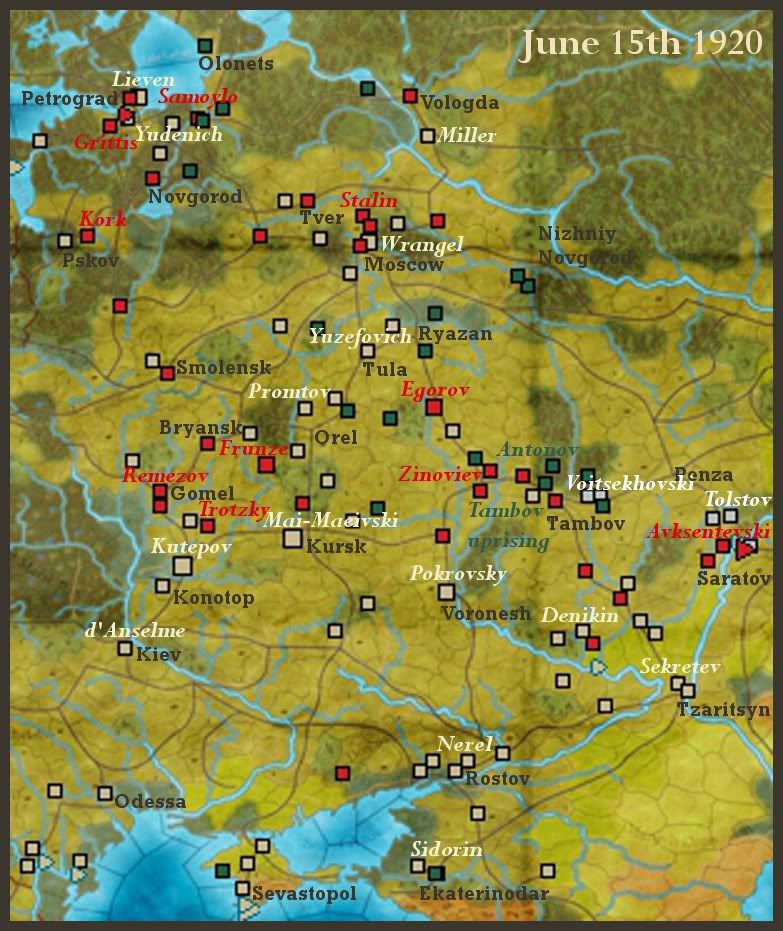
The fall of Tzaritsyn: For the last few weeks Sovnarkom had held back one piece of bad news from the public in Petrograd: Tzaritsyn had fallen to White forces under general Denikin on May 19th. When Tukhachevsky had headed north to participate in the pincer movement against Kursk, the city had been left behind almost defenseless. Denikin had hesitated long fearing a trap but finally he ordered an assault. The Red artillerymen defending the city fought bravely but were too badly outnumbered to stand a chance.
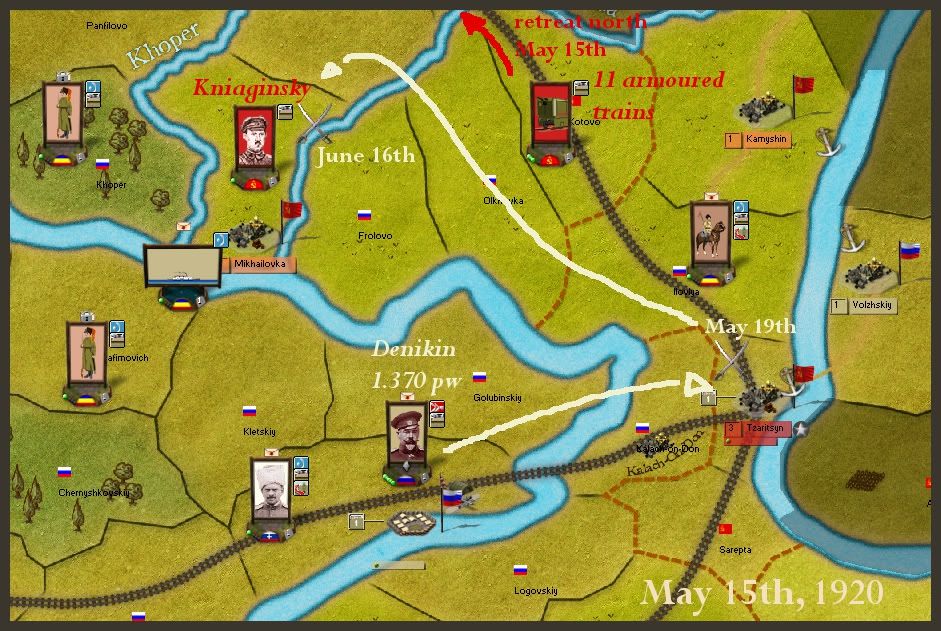
In June Denikin proceeded to clear the Don area of Red troops. The last battle in the South was fought on June 16th when Denikin took two cavalry divisions to retake Mikhailovka, the only remaining Bolshevik stronghold in the area. After a short but furious fight, Kniaginsky's force of 9.000 Bolsheviks was completely annihilated.
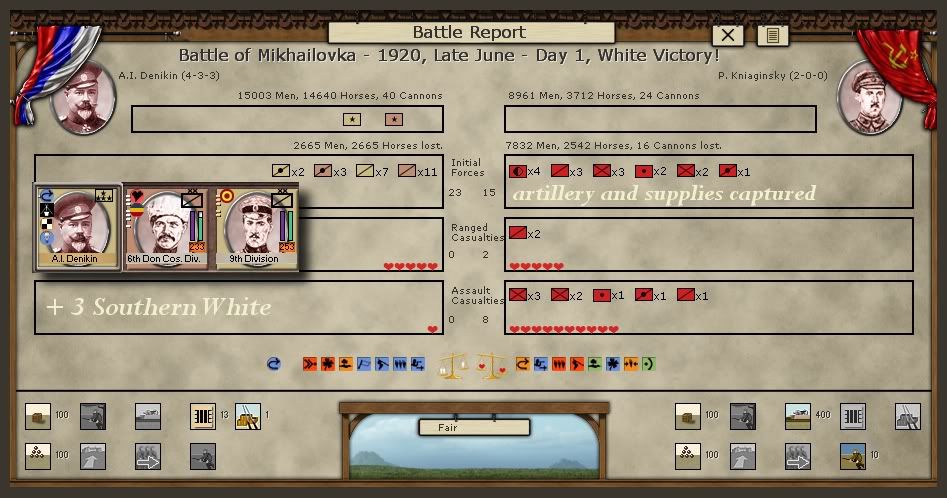
The Tambov uprising: While the Southern White had followed a rather lenient approach towards the peasant population, Bolsheviks and Siberian Whites had mercilessly exploited the peasants unlucky enough to live under their rule. For months large parts of the Siberian territory had been ravaged by peasant uprisings. The Far East and Kazakhstan were in danger of being lost completely to peasant armies, but Turkmenistan and Siberia suffered increasingly as well. Admiral Kolchak had responded ruthlessly; strong Siberian forces were dispatched to hunt down peasant rebels. At the end of the war more than 120.000 Green insurgents had fallen in battle, most of them at the hands of Kolchak's men. It was this experience that gained Kolchak the ministery of agriculture in the first post civil war government.
In June 1920, the Green struggle got a new quality. The countryside around Tambov exploded when over 50.000 peasants rose to form the United Guerilla Army of Tambov.2 It was the biggest Green uprising of the entire war. As usual the Green rebels lacked training but this time they were at least ably led by Antonov.3
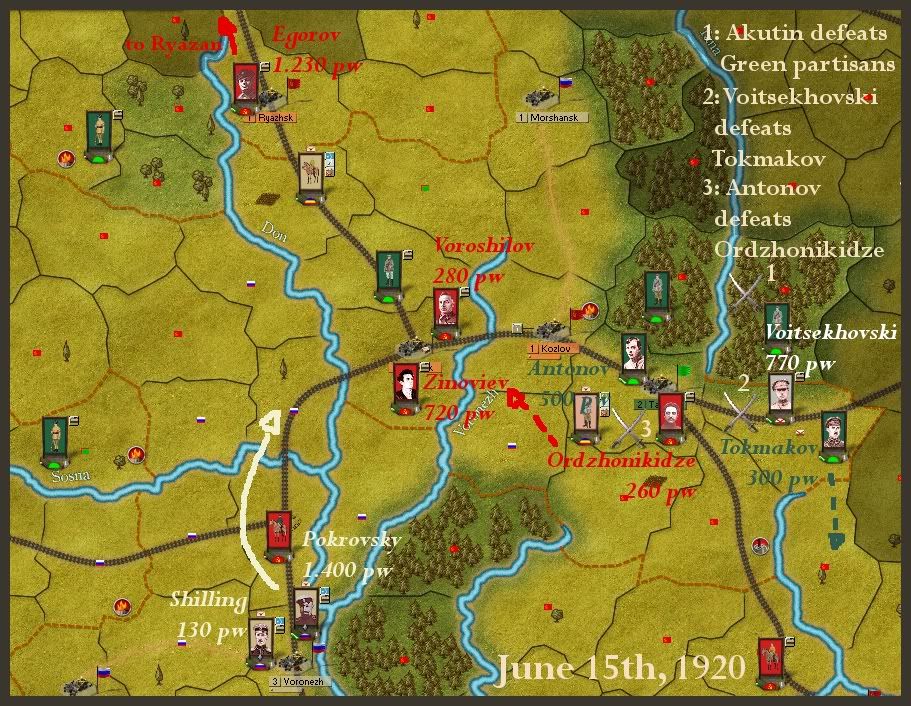
However Antonov's Army would have to fight from the very start of its existence since the surrounding area was occupied by enemy forces: To the West, Red forces under Egorov, Zinoviev and Voroshilov were hurrying north in a desperate bid to save Moscow. Ordzhonikidze brought up the rearguard and was still at Tambov. Antonov soundly beat his column and forced it to retreat.
To the East, Siberian forces under Akutin and Voitsekhovski were marching on Tambov. Unlike the Bolsheviks, the experienced Siberian counter-insurgency fighters remained victorious over Tokmakov's force. But even they didn't dare to attack Antonov head-on. While Tambov was taken in the last days of the war, Antonov's army remained at large in the countryside.4
Pokrovsky's corps abstained from the fighting. Part of his troops were send north to reinforce White positions along the Orel-Tula-Moscow railway, the rest secured the Southern White flank.
The siege of Petrograd: In the meantime, Petrograd, the new capital of Soviet Russia, remained under siege. However Lieven didn't feel strong enough to storm the city. Neither could he starve it since supplies continued to get into the city via its harbour.
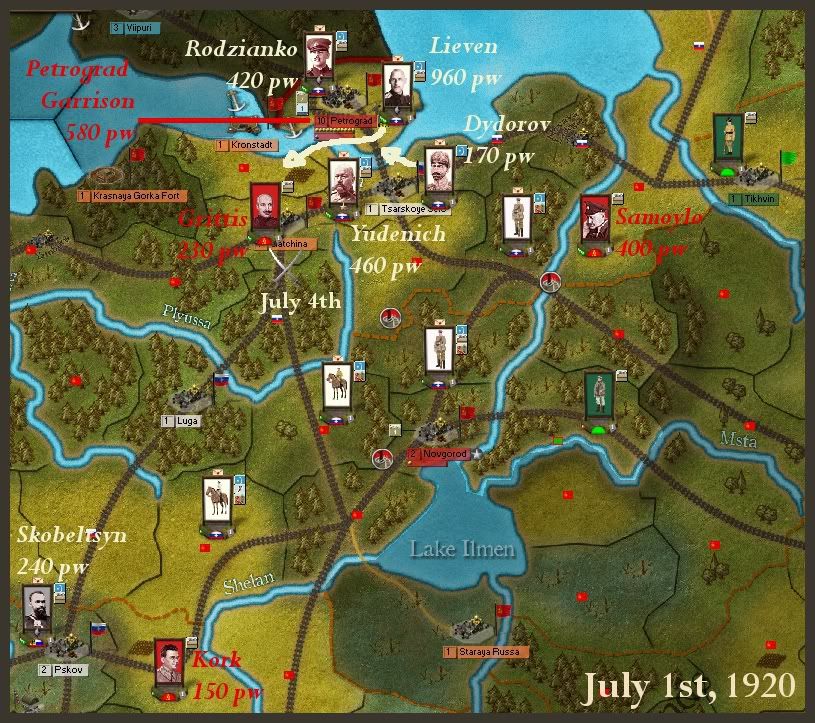
Moreover there remained three Red corps in the area that if unified could pose a threat to Yudenich's army. The White commanders decided to preempt such a move. On July 1st, Lieven left Petrogard with two-thirds of the siege force and attacked Grittis at Gatchina four days later. Grittis was hopelessly outnumbered: with 6.700 men he stood little chance of withstanding Lieven's 28.000. Most comabt units were annihilated, but Grittis was more concerned with saving his oversized baggage train anyway. The danger of a unified Red relief army loomed no longer.
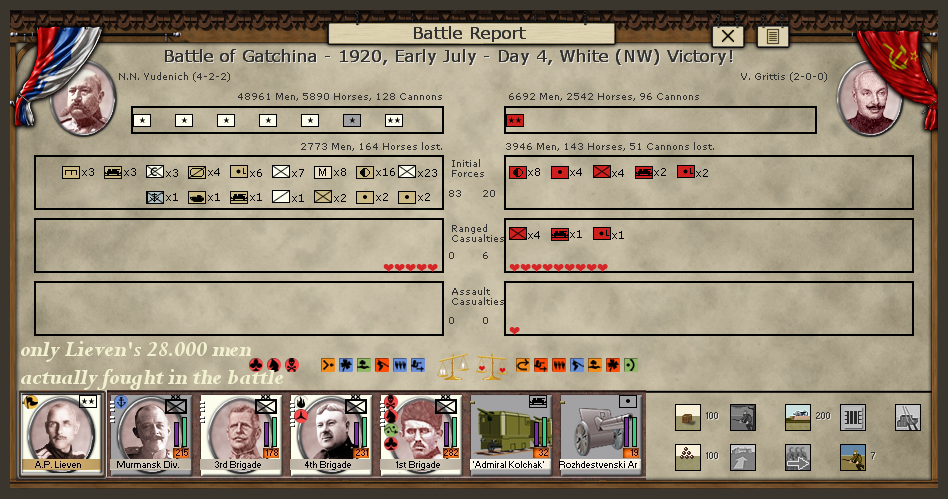
Lieven immediately returned to Petrogard and continued the siege until the end of the war.
The fall of Moscow: After Stalin's defeat the Red Army had started to rush the 2nd and 3rd Shock Armies north in the hope of saving the city.5 But Wrangel and Shkuro didn't wait for the Red Army to steal away their price. On July 1st, 111.000 White soldiers assaulted the city.
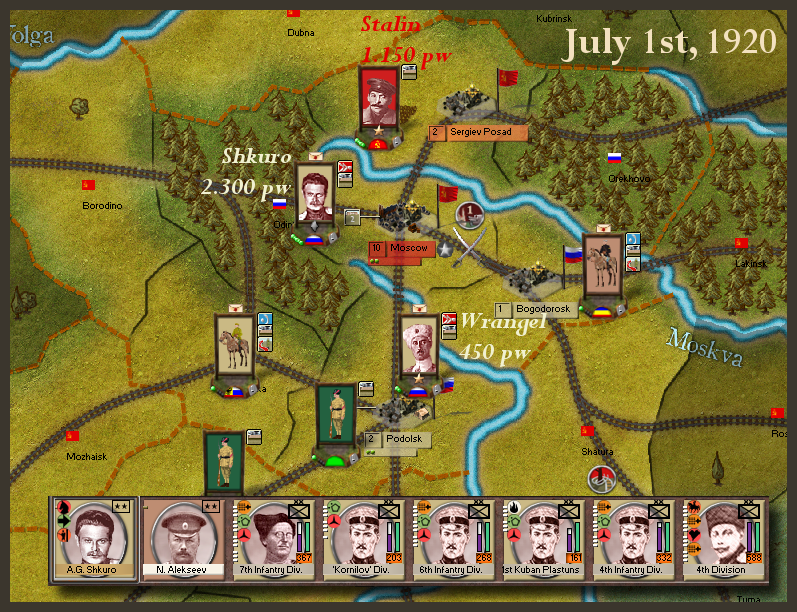
The remaining Red garrison numbered only 11.000 men under the command of Bonch-Bruevich. But they still had excellent artillery which wrecked havoc amongst the White units. Nevertheless, the Reds never stood a chance. After a heroic - if short - defense the last pockets of Red resistance in the city were crushed. By the end of the day, Wrangel and Shkuro were giving a banquette in the Kremlin while already plotting how to oust Denikin from power.6
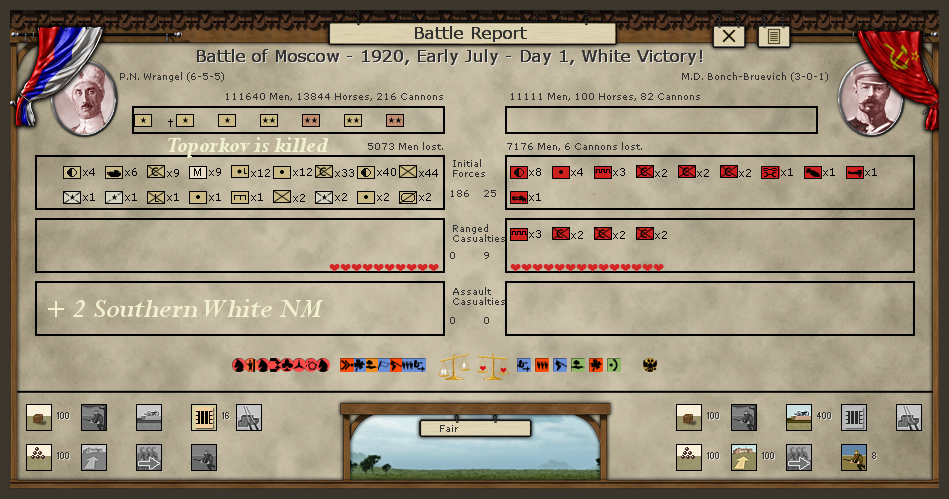
However the fighting around the city was not over yet: On July 9th, Zinoviev arrived at Ryazan and a day later Egorov reconquered Bogodorosk. The Red Army was still a force to be reckoned with. But the White commanders also knew that with Moscow in their hands, there was no longer a need to mount risky attacks. Hence Wrangel and Mai-Maeivski were contend to secure Moscow and Podolsk while Cherbachev left Orel to take over the defense of Tula.

Only Shkuro wasn't willed to commit to defensive warfare. Without noticing his peers, he departed with three elite divisions for a raid against Tver. The city was defended by newly recruited Communist infantrymen. They proved no match for Shkuro's battle hardened veterans.7 Shkuro was rather melancholic at the thought that this was to be the last city he would sacked during the civil war.

The end of the 2nd Shock Army: After its defeat at Kursk on May 25th, Frunze had retreated north with most of the surviving 80.000 men. However his situation quickly grew desperate: by June 15th, supplies were already running low. Nevertheless Frunze pushed his men onwards. Since the Red Army had long since lost control over the railway lines in the area, Frunze's men had to march over muddy roads. White historians believe Frunze's next decision was a desperate attempt to achieve his initial objective and cut the White supply lines towards Moscow. Whatever the reason, he turned east rather than try to esacpe to Gomel or Bryansk. A dangerous gambit to undertake with an army lacking supply reserves.
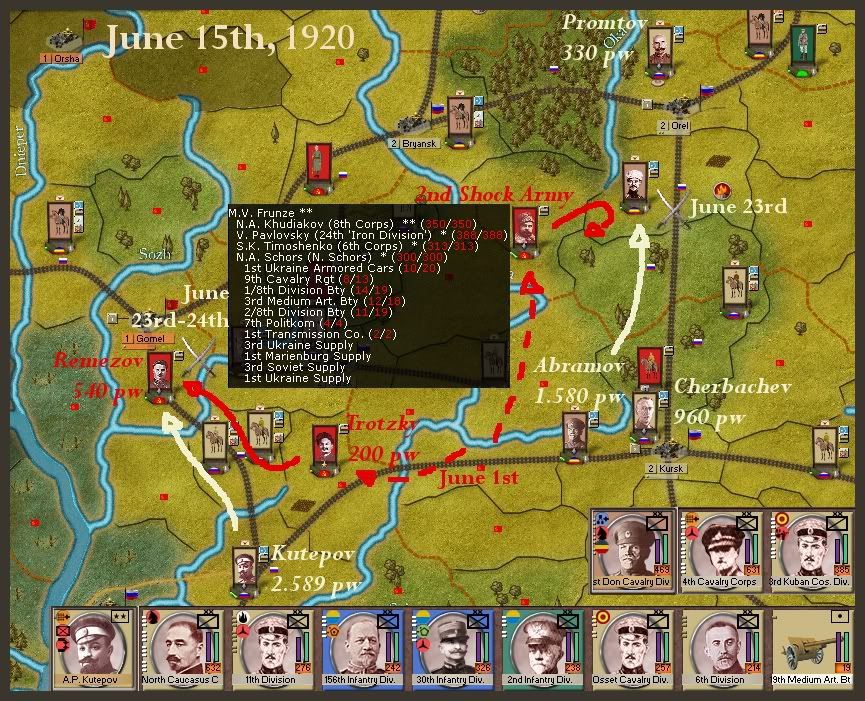
Frunze walked right into a White trap: Abramov - promoted to command a corps after the Battle of Kursk - had rushed three divisions north by railway.8 When Frunze arrived at Znamenka on June 23rd, Abramov's men were already waiting. In concequence, the 2nd Shock Army was repulsed bloodily. When the battle was over, 9.300 Bolshevik soldiers remained dead on the battlefield.
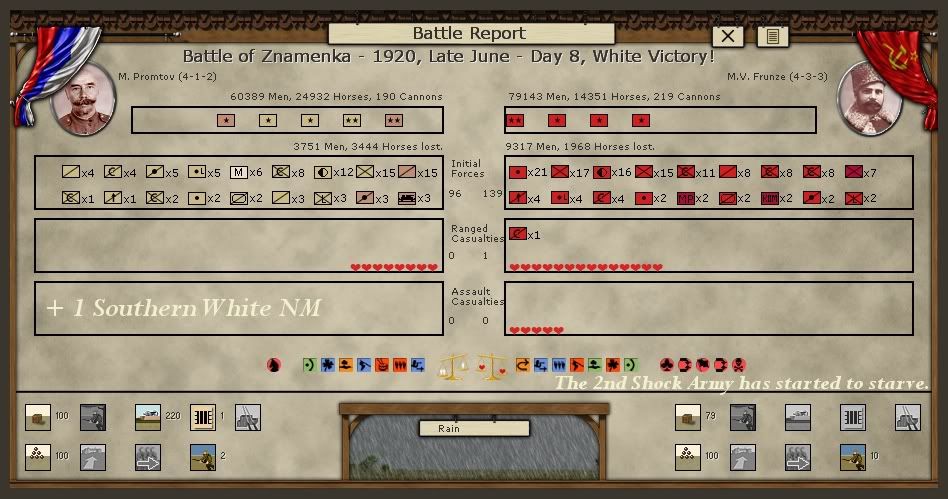
In the meantime, Kutepov hadn't been idle. Initialy it had been hoped that the 2nd Shock Army would fall back towards the West. Therefore Kutepov had headed north to interrupt the railway line from Kursk to Gomel.9 But once it had become clear that Frunze was heading north, Kutepov decided to attack Remezov at Gomel. On June 23rd, 69.000 French, Greek and Russian troops fell upon Remezov's 23.000 Bolsheviks. Well entrenched and protected behind River Iput, the Red Army offered fierce resistance. Since French and Greek divisions lagged behind, it were the Russian units that bore most of the 7.600 White casualties.10 But the Red Army had suffered even worse. Remezov lost almost 60% of his men and was left with less than 10.000 demoralized survivors.
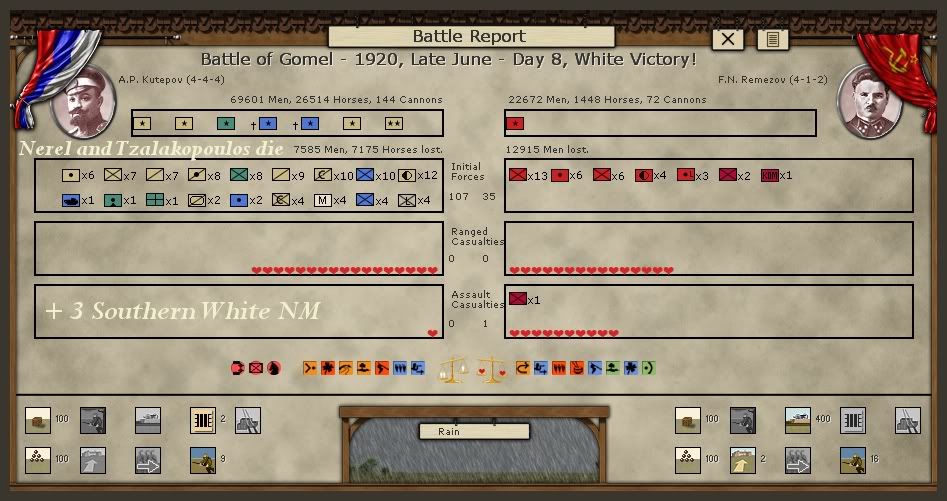
When Trotzky with a couple of armoured trains escorted by some cavalry regiments arrived at the city the next day, Remezov's men were already in full retreat. His trains were greeted by heavy artillery fire, followed by a wave of White infantry. Only Trotzky's personal train somehow managed to escape.
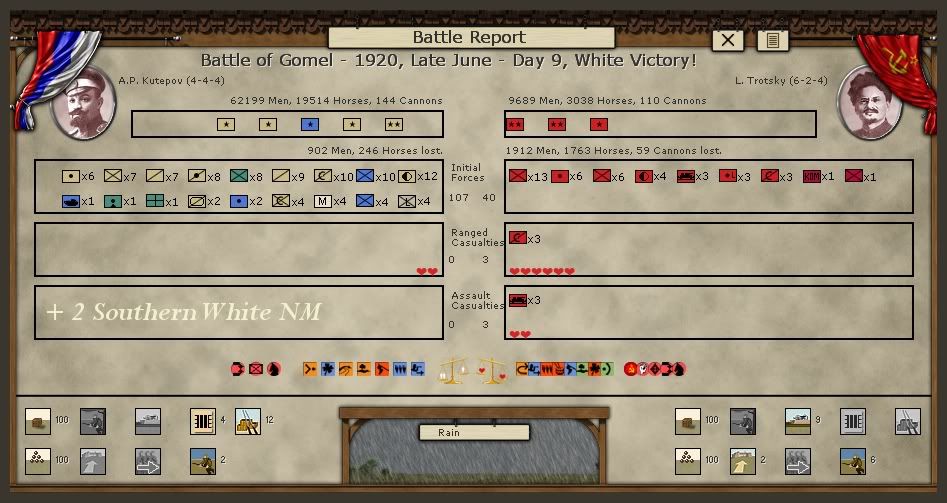
By July, Frunze's men were starving as well as utterly exhausted. They were still very numerous, though. Wrangel sent a short telegram outlining the next operations: "Hunting season is opened".

White generlas agreed that the 2nd Shock Army would most likely try to reach Bryansk. Kutepov and Abramov were dispatched to intercept and destroy the fleeing Communists. Unfortunately Abramov led Frunze slip through his fingers and then failed to pursue.11 Consequently only Kutepov's men were waiting for the 2nd Shock Army at Bryansk. Although outnumbered by 2 : 1, the White soldiers attacked ferociously.
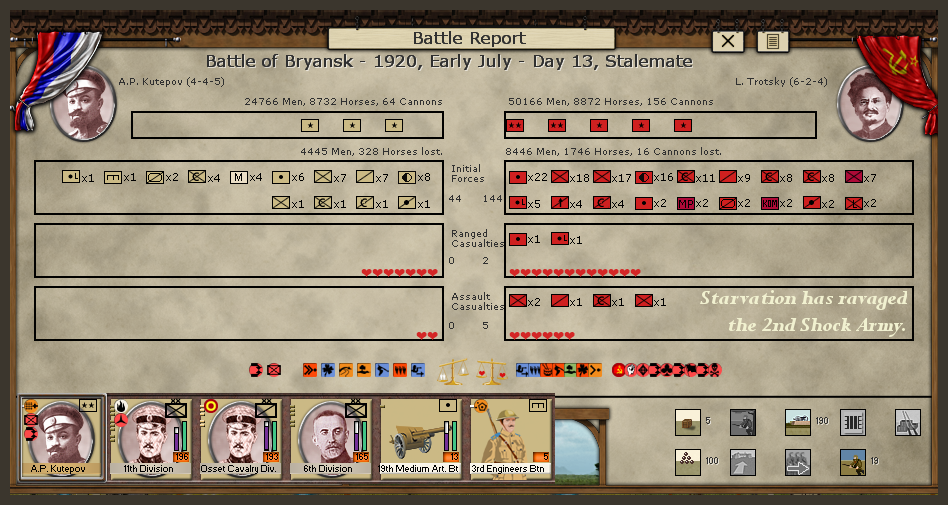
The battle raged for two days before Kutepov finally ordered a retreat. He left behind 8.600 fallen White soldiers. Although technically a defeat, his attack had also inflicted heavy casualties on the 2nd Shock Army: 12.500 Red soldiers were dead, several regiments had been entirely annihilated. Now less than 38.000 men were left of what had once been the biggest army assembled during the entire war.12
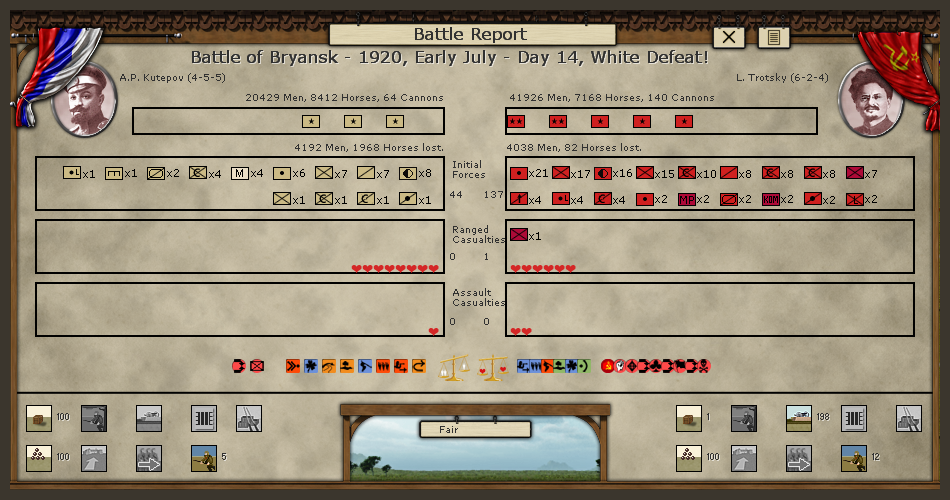
Nevertheless there was now a glimpse of hope for the 2nd Shock Army. At Bryanks its desperate men had found some supplies. But Frunze knew that he couldn't grant his men any rest. The White armies were bound to attack again. In his desperation he ordered a forced march north.
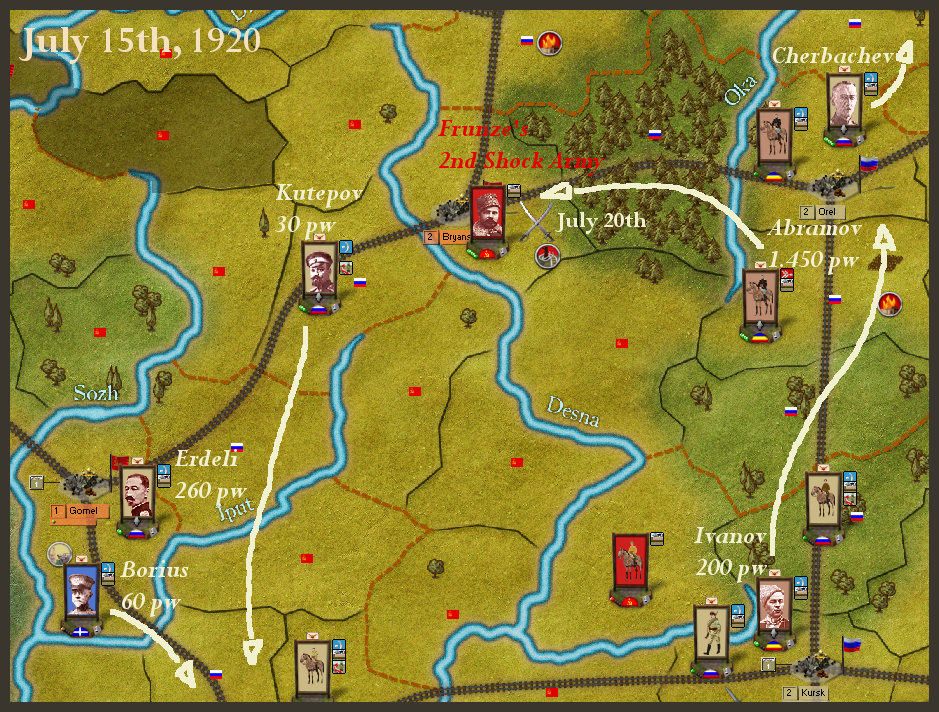
However his exhausted soldiers were too slow. On July 20th, Abramaov's men caught up with them. Numerically both armies were evenly matched: Trotzky and Frunze had 37.000 men against Abramov's 42.000. But the White soldiers were well rested and supplied while starvation as well as months of fighting and marching had utterly shattered Red moral and cohesion. What followed wasn't a battle but pure slaughter. For hours White soldiers hunted down fleeing Bolsheviks. The carnage only ended when nightfall allowed the last 13.000 survivors to escape. 23.600 Communist soldiers had fallen and 70 Communist regiments been destroyed. The 2nd Shock Army was no more.13
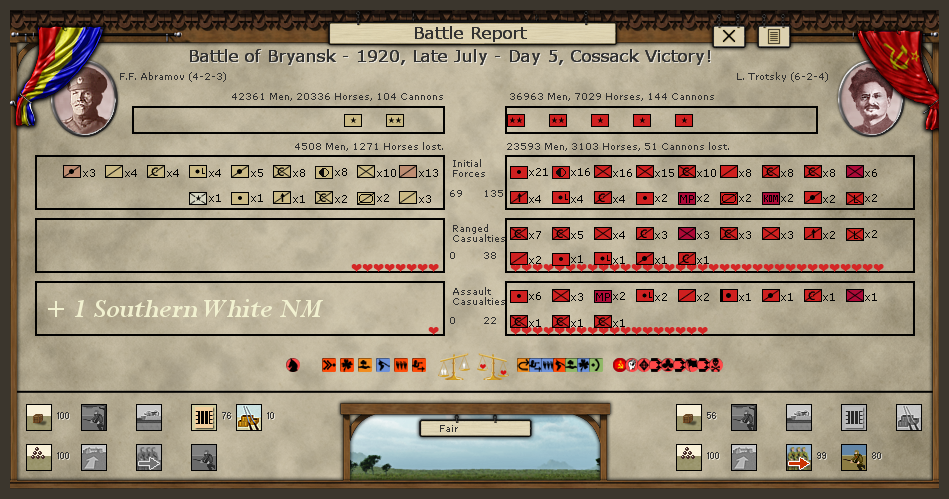
It was to be the last battle of the civil war. Since the Battle of Kursk on May 25th, Communist Russia had suffered one defeat after another: Petrograd was under siege, Moscow had fallen, Siberian armies were steadily advancing westward, Shkuro was running wild in the Red heartland ... and now the destruction of the 2nd Shock Army, the former pride of the Red Army. Within days of the Battle of Bryansk the Bolshevik party disintegrated. The members of Sovnarkom were seen sneeking into the night trying to find exile abroad. Mass desertion ravaged the remaining units of the Red Army.
The counter-revolution had won. Russia was saved from the yoke of Communism. The future held great promise: autocratic generals would enrich themselves, Coassacks would convince peasants of the dangers of land-reform and the newly reestablished Okhrana would dissuade workers from strikes and liberals from demanding silly things like constitutions or civil liberties. Once again Russia was a good place to live - at least if one had a general's epaulettes and a noble pedigree. Or as Denikin put it: "Injustice is dead; long live injustice!"
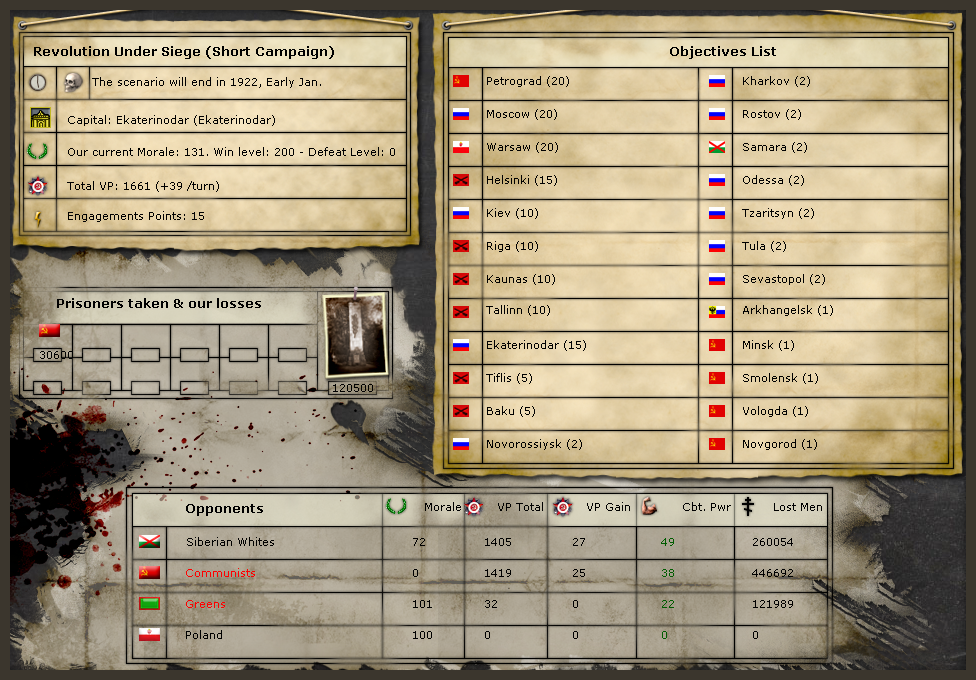
---------------------------------------------------------------
My dear readers, I hope you have enjoyed my second RUS AAR. Thank you for keeping up with me until the very end. Many of you have taken the time to comment, encourage or ask questions. Thank you so much! But most importantly, I want to thank Highlandcharge and Ashtray, two excellent players and true sportsmen. It was a great pleasure to share this game with you.
---------------------------------------------------------------
1 From the poem "White Guards" by Marina Tsvetaeva.
2 Unlike rebellions triggered by high Green loyalties, the Tambov uprising is scripted via event, it will always occurs in June 1920.
3 Antonov has stats that put him on par with the best generals in RUS: 5 strategic, 3 offensive, 5 defensive; add to that a number of very helpful special abilities (charismatic, militiaman, entrencher, superior withdrawer) and any other general but Wrangel is outmatched.
4 The Green AI marched Antonov's stack in the direction of Voronezh but quickly realized that the Southern White force guarding the city were too strong. When Antonov headed back, Tambov had already been taken by White cavalry.
5 Notice the Green rebels in the screenshot. With the conquest of Tula and Ryazan, I took over two areas that Highlandcharge had thoroughly exploited. As a consequence, Green loyalties had risen above 50%. I tried to reform but Green uprisings couldn't be prevented. Howvever they proved to be minor annoyances.
6 The fall of Moscow came with a heavy NM penalty for the Reds (-10 points of NM, but I may be wrong). At the end of the early July turn, Red NM was thus down to 3 points.
7 I could spare the units and it seemed like a good opportunity to steal a bit of NM from the Reds. With only 3 points of Red NM left, I could afford to go after easy targets rather than take risks.
8 The rain made it impossible for Frunze to reach Orel. I was pretty sure that Highlandcharge wouldn't turn west - his previous move had made it obvious that he intended to get Frunze back north. This left only two likely targets. Bryansk and Znamenka (the region south of Orel). I thought Frunze would most likely try to reach Bryansk but sent my units to Znamenka nevertheless because I couldn't afford to have the Kursk-Orel-Moscow railroad interrupted since it was my only supply line north. If I had known that Frunze's supplies were exhausted, I probably wouldn't have considered the Kursk-Orel railroad threatened at all. Thus lack of accurate intelligence ironically led me to the right decision.
9 It had seemed likely that Frunze would try to retreat towards Gomel (especially since it was the only way to get Trotzky and his armoured trains to safety). If he had, his force would have walked right into Kutepov's arms and I could have gained another defensive victory.
10 While the Greek and French units suffered hardly any casualties in this battle, I lost two of their generals: Nerel and Tzalakopoulos. It didn't matter much though since the war had now left the Ukraine for good. French and Greek units had thus become useless.
11 Abramov had movement orders to Bryansk, but somehow he got blocked by Frunze's retreating corps. I have no idea how this is even possible. I always thought units in passive posture can't block enemy movement.
12 Starvation was just as bad as the series of defeats, though. The 2nd Shock Army had lost almost 20.000 men to starvation at that point.
13 The Red NM loss from this battle is ridiculously low. But I believe there is a simple reason: heading into this battle the Reds had only 1 point of NM left. Usually a battle with this casualty ratio and a total of 70 destroyed elements is bound to cost a huge prize in NM.
In June 1920, Bolshevik Russia was in a desperate situation. Red forces were retreating on all fronts, Petrograd and Moscow were under siege and even die-hard Bolsheviks started to lose faith in the revolution. But the situation was about to get even worse ...

The fall of Tzaritsyn: For the last few weeks Sovnarkom had held back one piece of bad news from the public in Petrograd: Tzaritsyn had fallen to White forces under general Denikin on May 19th. When Tukhachevsky had headed north to participate in the pincer movement against Kursk, the city had been left behind almost defenseless. Denikin had hesitated long fearing a trap but finally he ordered an assault. The Red artillerymen defending the city fought bravely but were too badly outnumbered to stand a chance.

In June Denikin proceeded to clear the Don area of Red troops. The last battle in the South was fought on June 16th when Denikin took two cavalry divisions to retake Mikhailovka, the only remaining Bolshevik stronghold in the area. After a short but furious fight, Kniaginsky's force of 9.000 Bolsheviks was completely annihilated.

The Tambov uprising: While the Southern White had followed a rather lenient approach towards the peasant population, Bolsheviks and Siberian Whites had mercilessly exploited the peasants unlucky enough to live under their rule. For months large parts of the Siberian territory had been ravaged by peasant uprisings. The Far East and Kazakhstan were in danger of being lost completely to peasant armies, but Turkmenistan and Siberia suffered increasingly as well. Admiral Kolchak had responded ruthlessly; strong Siberian forces were dispatched to hunt down peasant rebels. At the end of the war more than 120.000 Green insurgents had fallen in battle, most of them at the hands of Kolchak's men. It was this experience that gained Kolchak the ministery of agriculture in the first post civil war government.
In June 1920, the Green struggle got a new quality. The countryside around Tambov exploded when over 50.000 peasants rose to form the United Guerilla Army of Tambov.2 It was the biggest Green uprising of the entire war. As usual the Green rebels lacked training but this time they were at least ably led by Antonov.3

However Antonov's Army would have to fight from the very start of its existence since the surrounding area was occupied by enemy forces: To the West, Red forces under Egorov, Zinoviev and Voroshilov were hurrying north in a desperate bid to save Moscow. Ordzhonikidze brought up the rearguard and was still at Tambov. Antonov soundly beat his column and forced it to retreat.
To the East, Siberian forces under Akutin and Voitsekhovski were marching on Tambov. Unlike the Bolsheviks, the experienced Siberian counter-insurgency fighters remained victorious over Tokmakov's force. But even they didn't dare to attack Antonov head-on. While Tambov was taken in the last days of the war, Antonov's army remained at large in the countryside.4
Pokrovsky's corps abstained from the fighting. Part of his troops were send north to reinforce White positions along the Orel-Tula-Moscow railway, the rest secured the Southern White flank.
The siege of Petrograd: In the meantime, Petrograd, the new capital of Soviet Russia, remained under siege. However Lieven didn't feel strong enough to storm the city. Neither could he starve it since supplies continued to get into the city via its harbour.

Moreover there remained three Red corps in the area that if unified could pose a threat to Yudenich's army. The White commanders decided to preempt such a move. On July 1st, Lieven left Petrogard with two-thirds of the siege force and attacked Grittis at Gatchina four days later. Grittis was hopelessly outnumbered: with 6.700 men he stood little chance of withstanding Lieven's 28.000. Most comabt units were annihilated, but Grittis was more concerned with saving his oversized baggage train anyway. The danger of a unified Red relief army loomed no longer.

Lieven immediately returned to Petrogard and continued the siege until the end of the war.
The fall of Moscow: After Stalin's defeat the Red Army had started to rush the 2nd and 3rd Shock Armies north in the hope of saving the city.5 But Wrangel and Shkuro didn't wait for the Red Army to steal away their price. On July 1st, 111.000 White soldiers assaulted the city.

The remaining Red garrison numbered only 11.000 men under the command of Bonch-Bruevich. But they still had excellent artillery which wrecked havoc amongst the White units. Nevertheless, the Reds never stood a chance. After a heroic - if short - defense the last pockets of Red resistance in the city were crushed. By the end of the day, Wrangel and Shkuro were giving a banquette in the Kremlin while already plotting how to oust Denikin from power.6

However the fighting around the city was not over yet: On July 9th, Zinoviev arrived at Ryazan and a day later Egorov reconquered Bogodorosk. The Red Army was still a force to be reckoned with. But the White commanders also knew that with Moscow in their hands, there was no longer a need to mount risky attacks. Hence Wrangel and Mai-Maeivski were contend to secure Moscow and Podolsk while Cherbachev left Orel to take over the defense of Tula.

Only Shkuro wasn't willed to commit to defensive warfare. Without noticing his peers, he departed with three elite divisions for a raid against Tver. The city was defended by newly recruited Communist infantrymen. They proved no match for Shkuro's battle hardened veterans.7 Shkuro was rather melancholic at the thought that this was to be the last city he would sacked during the civil war.

The end of the 2nd Shock Army: After its defeat at Kursk on May 25th, Frunze had retreated north with most of the surviving 80.000 men. However his situation quickly grew desperate: by June 15th, supplies were already running low. Nevertheless Frunze pushed his men onwards. Since the Red Army had long since lost control over the railway lines in the area, Frunze's men had to march over muddy roads. White historians believe Frunze's next decision was a desperate attempt to achieve his initial objective and cut the White supply lines towards Moscow. Whatever the reason, he turned east rather than try to esacpe to Gomel or Bryansk. A dangerous gambit to undertake with an army lacking supply reserves.

Frunze walked right into a White trap: Abramov - promoted to command a corps after the Battle of Kursk - had rushed three divisions north by railway.8 When Frunze arrived at Znamenka on June 23rd, Abramov's men were already waiting. In concequence, the 2nd Shock Army was repulsed bloodily. When the battle was over, 9.300 Bolshevik soldiers remained dead on the battlefield.

In the meantime, Kutepov hadn't been idle. Initialy it had been hoped that the 2nd Shock Army would fall back towards the West. Therefore Kutepov had headed north to interrupt the railway line from Kursk to Gomel.9 But once it had become clear that Frunze was heading north, Kutepov decided to attack Remezov at Gomel. On June 23rd, 69.000 French, Greek and Russian troops fell upon Remezov's 23.000 Bolsheviks. Well entrenched and protected behind River Iput, the Red Army offered fierce resistance. Since French and Greek divisions lagged behind, it were the Russian units that bore most of the 7.600 White casualties.10 But the Red Army had suffered even worse. Remezov lost almost 60% of his men and was left with less than 10.000 demoralized survivors.

When Trotzky with a couple of armoured trains escorted by some cavalry regiments arrived at the city the next day, Remezov's men were already in full retreat. His trains were greeted by heavy artillery fire, followed by a wave of White infantry. Only Trotzky's personal train somehow managed to escape.

By July, Frunze's men were starving as well as utterly exhausted. They were still very numerous, though. Wrangel sent a short telegram outlining the next operations: "Hunting season is opened".

White generlas agreed that the 2nd Shock Army would most likely try to reach Bryansk. Kutepov and Abramov were dispatched to intercept and destroy the fleeing Communists. Unfortunately Abramov led Frunze slip through his fingers and then failed to pursue.11 Consequently only Kutepov's men were waiting for the 2nd Shock Army at Bryansk. Although outnumbered by 2 : 1, the White soldiers attacked ferociously.

The battle raged for two days before Kutepov finally ordered a retreat. He left behind 8.600 fallen White soldiers. Although technically a defeat, his attack had also inflicted heavy casualties on the 2nd Shock Army: 12.500 Red soldiers were dead, several regiments had been entirely annihilated. Now less than 38.000 men were left of what had once been the biggest army assembled during the entire war.12

Nevertheless there was now a glimpse of hope for the 2nd Shock Army. At Bryanks its desperate men had found some supplies. But Frunze knew that he couldn't grant his men any rest. The White armies were bound to attack again. In his desperation he ordered a forced march north.

However his exhausted soldiers were too slow. On July 20th, Abramaov's men caught up with them. Numerically both armies were evenly matched: Trotzky and Frunze had 37.000 men against Abramov's 42.000. But the White soldiers were well rested and supplied while starvation as well as months of fighting and marching had utterly shattered Red moral and cohesion. What followed wasn't a battle but pure slaughter. For hours White soldiers hunted down fleeing Bolsheviks. The carnage only ended when nightfall allowed the last 13.000 survivors to escape. 23.600 Communist soldiers had fallen and 70 Communist regiments been destroyed. The 2nd Shock Army was no more.13

It was to be the last battle of the civil war. Since the Battle of Kursk on May 25th, Communist Russia had suffered one defeat after another: Petrograd was under siege, Moscow had fallen, Siberian armies were steadily advancing westward, Shkuro was running wild in the Red heartland ... and now the destruction of the 2nd Shock Army, the former pride of the Red Army. Within days of the Battle of Bryansk the Bolshevik party disintegrated. The members of Sovnarkom were seen sneeking into the night trying to find exile abroad. Mass desertion ravaged the remaining units of the Red Army.
The counter-revolution had won. Russia was saved from the yoke of Communism. The future held great promise: autocratic generals would enrich themselves, Coassacks would convince peasants of the dangers of land-reform and the newly reestablished Okhrana would dissuade workers from strikes and liberals from demanding silly things like constitutions or civil liberties. Once again Russia was a good place to live - at least if one had a general's epaulettes and a noble pedigree. Or as Denikin put it: "Injustice is dead; long live injustice!"

---------------------------------------------------------------
My dear readers, I hope you have enjoyed my second RUS AAR. Thank you for keeping up with me until the very end. Many of you have taken the time to comment, encourage or ask questions. Thank you so much! But most importantly, I want to thank Highlandcharge and Ashtray, two excellent players and true sportsmen. It was a great pleasure to share this game with you.
---------------------------------------------------------------
1 From the poem "White Guards" by Marina Tsvetaeva.
2 Unlike rebellions triggered by high Green loyalties, the Tambov uprising is scripted via event, it will always occurs in June 1920.
3 Antonov has stats that put him on par with the best generals in RUS: 5 strategic, 3 offensive, 5 defensive; add to that a number of very helpful special abilities (charismatic, militiaman, entrencher, superior withdrawer) and any other general but Wrangel is outmatched.
4 The Green AI marched Antonov's stack in the direction of Voronezh but quickly realized that the Southern White force guarding the city were too strong. When Antonov headed back, Tambov had already been taken by White cavalry.
5 Notice the Green rebels in the screenshot. With the conquest of Tula and Ryazan, I took over two areas that Highlandcharge had thoroughly exploited. As a consequence, Green loyalties had risen above 50%. I tried to reform but Green uprisings couldn't be prevented. Howvever they proved to be minor annoyances.
6 The fall of Moscow came with a heavy NM penalty for the Reds (-10 points of NM, but I may be wrong). At the end of the early July turn, Red NM was thus down to 3 points.
7 I could spare the units and it seemed like a good opportunity to steal a bit of NM from the Reds. With only 3 points of Red NM left, I could afford to go after easy targets rather than take risks.
8 The rain made it impossible for Frunze to reach Orel. I was pretty sure that Highlandcharge wouldn't turn west - his previous move had made it obvious that he intended to get Frunze back north. This left only two likely targets. Bryansk and Znamenka (the region south of Orel). I thought Frunze would most likely try to reach Bryansk but sent my units to Znamenka nevertheless because I couldn't afford to have the Kursk-Orel-Moscow railroad interrupted since it was my only supply line north. If I had known that Frunze's supplies were exhausted, I probably wouldn't have considered the Kursk-Orel railroad threatened at all. Thus lack of accurate intelligence ironically led me to the right decision.
9 It had seemed likely that Frunze would try to retreat towards Gomel (especially since it was the only way to get Trotzky and his armoured trains to safety). If he had, his force would have walked right into Kutepov's arms and I could have gained another defensive victory.
10 While the Greek and French units suffered hardly any casualties in this battle, I lost two of their generals: Nerel and Tzalakopoulos. It didn't matter much though since the war had now left the Ukraine for good. French and Greek units had thus become useless.
11 Abramov had movement orders to Bryansk, but somehow he got blocked by Frunze's retreating corps. I have no idea how this is even possible. I always thought units in passive posture can't block enemy movement.
12 Starvation was just as bad as the series of defeats, though. The 2nd Shock Army had lost almost 20.000 men to starvation at that point.
13 The Red NM loss from this battle is ridiculously low. But I believe there is a simple reason: heading into this battle the Reds had only 1 point of NM left. Usually a battle with this casualty ratio and a total of 70 destroyed elements is bound to cost a huge prize in NM.
again thanks to all of you ... that was a superb read as well as a superb game. The big situation map at the start of that update showed just how much you'd utterly disrupted the Reds, but that was still an epic chase after 2nd Shock ... & post-game of course the inevitable clash among the Whites ...
those unit losses for 2 Shock show how badly armies can suddenly fall apart in the AGEOD system ... as I can testify from bitter experience
those unit losses for 2 Shock show how badly armies can suddenly fall apart in the AGEOD system ... as I can testify from bitter experience
Congrats! The obliteration of the 2nd Shock Army was a perfect climax and end to the war and game.
Sweet victory! Reds were thoroughly crushed. And now, give us a rematch with you on the Red side, if you would be so kind, good sir.
those unit losses for 2 Shock show how badly armies can suddenly fall apart in the AGEOD system ... as I can testify from bitter experience
If an army gets hunted long enough it will eventually crumble. But the 2nd Shock Army didn't fall apart fast. It fought 5 battles within 5 turns during 3 of which it also suffered hits from lack of supplies. To me it seems rather realistic that an army would fall apart under those circumstances. But granted the 2nd Shock Army imploded in a spectacular way (I don't think I have ever seen this many elements lost in a single battle).
In my opinion, you recognize the really good players by their ability to extract armies successfully from situations like this one.
Congrats! The obliteration of the 2nd Shock Army was a perfect climax and end to the war and game.
What I loved about this game was how it started with careful maneuvering, feints and traps - Highlandcharge is excellent at avoiding those - but eventually developped into a huge slugging match with massive armies colliding. In the entire game I lost 120.000 men, 57.000 of those were lost in the last four turns of this game.
It made for a very nice story, Kursk was clearly the climax but the ending was a series of fireworks as well.
Sweet victory! Reds were thoroughly crushed. And now, give us a rematch with you on the Red side, if you would be so kind, good sir.
Aren't you bloodthirsty.
What struck me most from the last strategic map was how much this was a war of manoeuvre, a war of capturing cities and important junctions. The Red, White and Green forces are horribly intermingled, there's hardly anything like a front line... And yet, it is very clear that the Communists are losing, even while they still command large armies.
Impressive job finishing off the Communist menace and you did it in style, with sweeping victories in cities and the utter destruction of the crown jewel of the Red Army.
Oh, and this:
Ouch. I guess Kolchak really knows how to fertilize the soil for those peasants that remain to work/slave over it?
Impressive job finishing off the Communist menace and you did it in style, with sweeping victories in cities and the utter destruction of the crown jewel of the Red Army.
Oh, and this:
At the end of the war more than 120.000 Green insurgents had fallen in battle, most of them at the hands of Kolchak's men. It was this experience that gained Kolchak the ministery of agriculture in the first post civil war government.
Ouch. I guess Kolchak really knows how to fertilize the soil for those peasants that remain to work/slave over it?
Heh. This was a fun AAR. Koltchak wouldn't be traveling around planting crops though. There would've been a power struggle between Koltchak and Denikin, and probably Mai-Mai and Wrangel and others as well. The disparate nature of the white forces is as big of a handicap as numbers were according to my understanding of the conflict so far. Still, Bornego has shown great ability in handling the White forces. I'm definitely looking forward to future AAR's here. 

